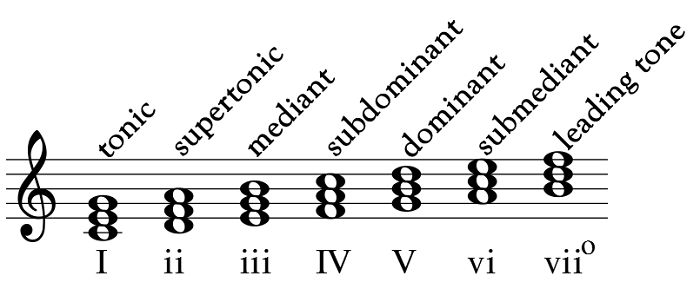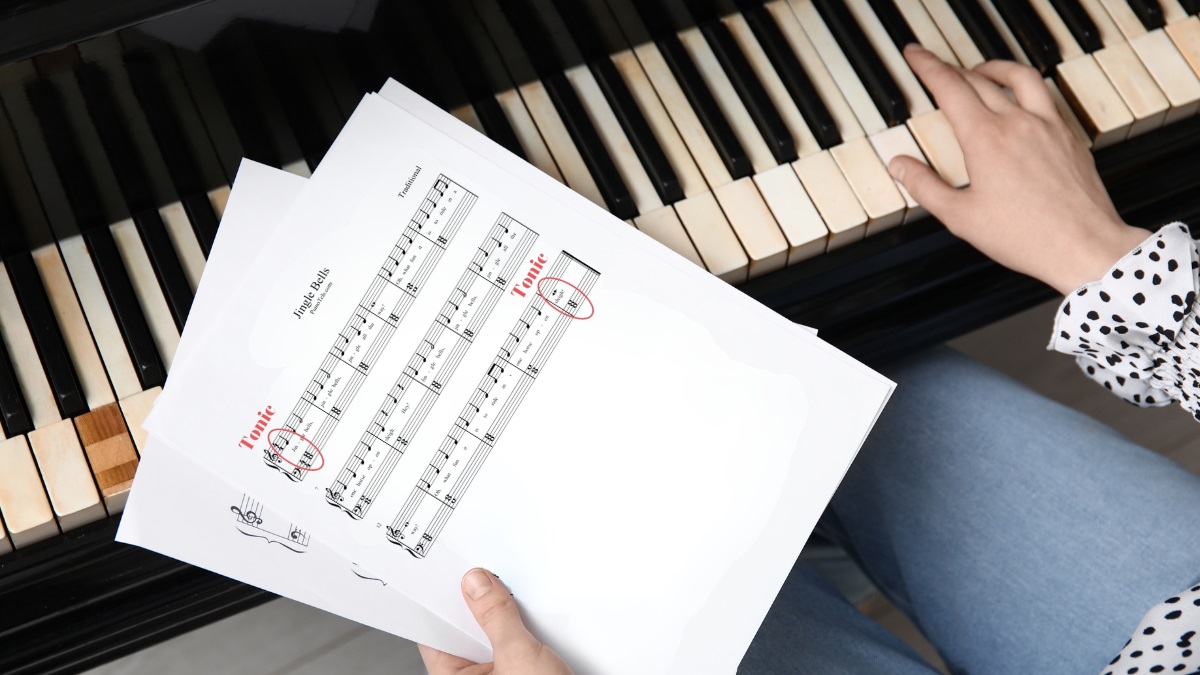You’re here because your interest in music goes beyond listening to a succession of pretty sounds, so kudos to you. But as you may have already found out, the world of music is in no shortage of terms that can be confusing or even scary at times.
Since I’ve taken it upon myself to make music less complicated for anyone bold enough to learn more about it, today I’m answering the question: what is tonic in music?
Understanding the meaning of tonic puts you on the right track to finding out how music gets organized. Once you know what that term means, you should practice being able to find the tonic in songs. This is one of the most important skills to learn for any type of musician, whether singing, playing an instrument, or composing a piece.
In this article, I’ll be explaining what the tonic is, why it is important to pinpoint, how you can find the tonic of a song, where it stands among the technical names, as well as discussing the differences between the tonic and the root.
What is Tonic in Music
In music, the tonic is the first note (or scale degree) of the diatonic scale. The tonic also refers to the final resolution tone or the tonal center that appears in the last cadence in tonal music whether it’s classical, traditional, or popular music.
The term tonic in music can also describe the tonic triad (chord) or the tonic function.
Explaining the Tonic
Time to explain what I just said in the section above in a simpler way. So, the tonic is basically the note or pitch that clues you in about the construction of a melodic arrangement and helps you understand a song’s form as well as the harmony of a piece.
For most musicians, the tonic is the North on their musical compass — the one thing they’re certain of and can always come back to when lost.
As I said earlier, the tonic is the initial note or scale degree of the diatonic scale. For example, if the key is A-flat major, then the tonic is A-flat. If you’re in C major, then the tonic is C. You can conclude from these examples that scales get their names from their tonics.
By now, you can probably tell that the tonic, in any key, is the primary note. So it’ll make sense when I tell you that there’s another name for the tonic: the keynote.

Also, the tonic in music refers to the final resolution tone or the tonal center that appears in the last cadence in tonal music whether it’s classical, traditional, or popular music. In short, the tonic is what gives a song or a musical section its sense of finality or closure as it’s built on it.
In music, the term tonic can also refer to the tonic triad (chord), which is formed on the first scale degree or “built on thirds”. For example, the tonic chord or triad In C major is the C major triad C–E–G, while in A-flat major, the tonic chord is the A-flat major triad A♭–C–E♭.
Finally, the term tonic may also refer to a type of harmonic function called tonic function or “ton” to abbreviate. When a chord is characterized by having a tonic function, this means it has a tendency to remain stable and at rest. In other words, a tonic chord doesn’t require progression to different chords.
Why is Finding the Tonic an Important Skill?
In the intro of this article, I mentioned that once you understand what the term tonic means, you should practice finding the tonic in songs and musical sections. I said that this skill is very important to master, but why is that?
Well, if you want to sing or play in tune, finding the tonic is how you’re going to make that happen. It doesn’t matter whether you’re an amateur or a professional musician, the tonic of a song will help you figure out what’s going on when you get lost.
For example, if there’s a harmonic progression you can’t seem to get or if you can’t quite make out a secondary voice, you can locate the correct pitch and have better knowledge of the context of the element you’re looking to understand by falling back on the tonic.
Additionally, knowing the tonic of a song helps singers stay away from notes that are out of their vocal range. This is why singers often need to change the key.

What’s more, finding the tonic offers musicians the following benefits:
- You get to develop your musical experience
- You can form a more precise idea of the notes you need to use to recreate what you hear
- You can join other musicals in play sessions without using a written score
- You can transcribe music faster when you hear it
- It makes it easier to identify the correct notes in a complex melody, even if there’s no written score (covering Jimmy Hendrix anyone?)
- It helps you transcribe the music that you create in your head
- It enables you to do a better job when improvising
- It helps composers get over their block whenever they need to come up with a new tune section
The Tonic in Relation to the Technical Names
In music, the technical names are a group of seven terms that we use to designate each note of the scale with a certain label. Each of these names indicates a different position for its respective note in the scale.
Here’s a simple breakdown of the 7 technical names:
- Tonic first degree or note of the scale — I already explained this one, so just think of it as the home sound.
- Supertonic, the second degree or note of the scale — the prefix ‘super’ generally refers to being ‘more’ or ‘after’. As such, this note follows the tonic in position.
- Mediant, the third degree or note of the scale — this name is derived from the word ‘medi’, which is Latin for medium. The mediant chord is positioned halfway between the tonic and the dominant.

- Subdominant, the fourth degree or note of the scale — the word ‘sub’ generally refers to being ‘less’ or ‘below’. As such, it makes sense that this note is called subdominant as it’s fifth down from the tonic.
- Dominant, the fifth degree or note of the scale — fifth up from the keynote, this is the most critical tone in terms of importance after the tonic. In fact, the dominant chord is what gives the tonic note its “tonic” status. This is because a single chord or note on its own may belong to different keys, but when the same note is paired with its dominant, it gets established as the tonic.
- Submediant, the sixth degree or note of the scale — similar to the mediant being halfway between the tonic and dominant, the submediant also sits halfway between the tonic and subdominant. It features the prefix ‘sub’ for the same reason I talked about above.
- Leading tone, the seventh degree or note of the scale — this note is called so because it leads or resolves to the tonic once again.
Before I wrap up this part, I’d like to emphasize that the technical names serve only as an indication of the position of the notes along the scale. In other words, we don’t use them to designate specific notes.
For example, if the scale is C major, then the tonic is the note C. But if you’re on the B major scale, then the tonic note is B and the supertonic note becomes C.
How to Find the Tonic of any Song
To help you learn how to find the tonic of any song, I think it’s best that you first understand how the tonic relates to other notes, then get familiar with its position within a scale or composition as well as the way it sounds.
As I mentioned earlier, the tonic is the home sound of a song or a musical section. It’s also the position where the music naturally rests.

As such, not only does a melody start with the tonic note, but it may finish on the tonic as well. This is what gives songs that sense of closure or completeness.
So when you listen to music that invokes a feeling of finality at the end, chances are that the melody ends or resolves on the tonic.
A good exercise here is to listen to a bunch of your favorite songs and try to identify the note where you think the music naturally rests. In most songs, you’ll discover that the music ends on the keynote or a note belonging to the tonic chord.
While listening, answer the following questions:
- Did the song start on the tonic?
- What is the note that the music ended on? Did it feel complete and as if it was supposed to naturally rest there?
- What is the song’s key?
If you’re having a hard time singling out the tonic, it can help you if you write out the melody. Make sure you start with the last note and continue in ascending order with the other notes. This way, you can pinpoint the key, and consequently, find the tonic of the song.
If nothing is working and you can’t tell whether the tonic is the last note or not, keep an ear out for the lowest note, which is most probably a bass note. This might give you a clue.
Can the leading tone help you find the tonic?

Yes, this is possible because the leading tone usually “leads” into the tonic to finish the melody. By definition, if the tonic refers to the place where the melody naturally rests, the leading tone is the place that naturally resolves to the tonic.
As I explained earlier, the leading tone is the seventh degree or note of the scale, which positions it half a step below the keynote.
Why is it tricky to find the tonic?
Although there are several tricks, tips, and clues out there to help musicians and singers find the tonic, there are still a few challenges that can make the process tricky.
I’m a firm believer that to beat an enemy, you need to know the enemy. So, here are the issues that may stand in your way of figuring out the tonic:
1. Modulation
When the music changes keys, this is called modulation. The good thing about modulation is that it spices things up and connects various musical ideas together.
The bad thing? Well, changing the keys also changes the tonic.
2. Alternating scales
When the music alternates between minor and major scales, expect the tonic to change as well.
3. Modern composition systems
Some of the more modern composition systems don’t use a tonic. Examples of such systems include serialism and atonalism.
In serialism, composers use notes in a particular order to create a music piece. In atonality, music doesn’t feature a key or a tonal center.
The common factor in both cases is the music isn’t written in any specific key, so there’s no need for a tonic note.
4. The use of modes instead of scales
If the melody uses modes such as Lydian or Dorian instead of scales (either major or minor), this causes a change in the tonal system in which case you’d need extra practice to be able to identify the tonic.

Are the Tonic and the Root the Same Thing?
No, the tonic isn’t the same thing as the root. The tonic is the home sound or note of the key or scale used, however, the root is the main pitch of chords and arpeggios.
The tonic and the root may accidentally end up being the same note, but that doesn’t mean they’re the same thing. It’s just how music works!
What is the Difference between the Tonic and the Bass Note?
The bass note is the lowest note at a given moment.







